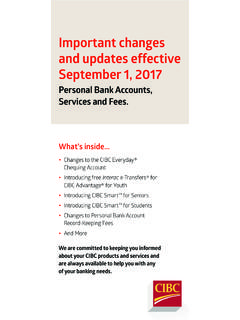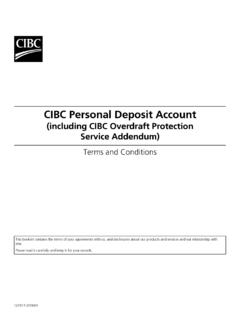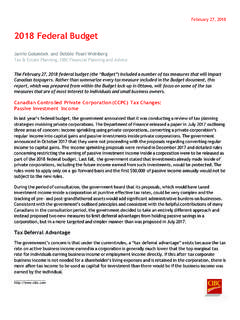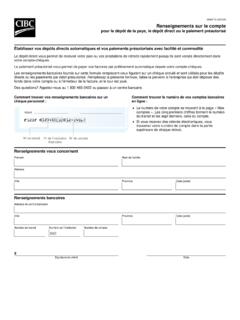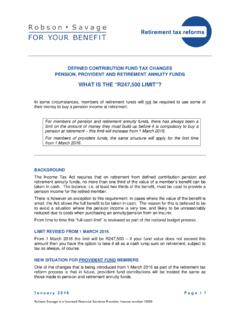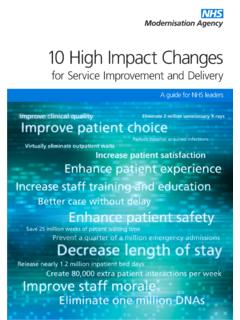Transcription of Do you know your tax rate - Financial Services | CIBC
1 April 2018 _____ It's 2018 Do you know what your tax rate is? Jamie Golombek M anaging Director, Tax & Estate Planning, CIBC Financial Planning and advice Tax rates can vary with changes in government legislation and your level and type of income. Do you know what your tax rate will be in 2018? This Report will help you to understand how your income is taxed and why the advertised tax rate isn t always what you end up paying. Graduated tax rates Canadian individuals pay taxes at graduated rates , meaning that your rate of tax gets progressively higher as your taxable income increases.
2 Figure 1 shows the federal tax rates that apply at various levels of taxable income for 2018. Figure 1: Federal tax rates at varying levels of taxable income in 2018 Taxable income 2018 $46,605 > $46,605 and $93,208 > $93,208 and $144,489 > $144,489 and $205,842 > $205,842 For example, on the first $46,605 of taxable income, you would pay federal tax at a rate of 15%. In contrast, taxable income exceeding $205,842 is taxed at 33%. Income inclusions, deductions & credits While graduated tax rates are applied to taxable income, not all income is included and certain amounts may be deducted in determining taxable income, thereby reducing the base to which marginal tax rates are applied.
3 Capital gains are an example of income that is only partially taxed. Unlike interest income that is fully in clu d e d in t axab le in co me , o n ly 50% o f cap it al gain s (le s s cap it al lo s s e s ) are in clu d e d . The remaining 50% is excluded from income and tax is saved at your marginal rate on this excluded half of net capital gains. CIBC It's 2018 Do you know what your tax rate is? April 2018 2 For example, let s say you realized net capital gains of $10,000 from the sale of shares.
4 Only half of this amount ($5,000) would be taxed. If instead you earned interest income of $10,000, you would pay tax on the entire amount. Common deductions that you may subtract from your total income, thereby decreasing your taxable income, include investment management fees for non-registered accounts, contributions to a Registered Retirement Savings Plan (RRSP), and child care expenses. In contrast to deductions, tax credits directly reduce the tax you pay after marginal tax rates have been applied to your taxable income.
5 With tax credits, a fixed rate is applied to eligible amounts and the resultant credit amount offsets taxes payable. Figure 2 shows that when the federal tax credit rate of 15% is applied to a $1,000 amount, $150 of tax savings results. Common federal non-refundable tax credits include the basic personal amount, the amount for a spouse or partner, medical expenses and charitable donations. A non-refundable tax credit is also available to investors who receive dividends from Canadian corporations, to recognize the fact that tax was already paid on the income by the corporation.
6 Canadian dividends are typically classified as either eligible or non-e ligib le . Eligible dividends are most commonly received from Canadian publicly-traded companies or mutual funds that hold Canadian dividend-paying equities. An enhanced dividend tax credit is available to an individual who receives e ligib le dividends to compensate for the high rate of tax that was paid when income was initially earned and taxed in the corporation. Non-eligible dividends would typically be received from a private Canadian corporation that paid tax on its corporate income at t h e lo w , s mall b u s in es s rate.
7 Because tax is paid at a low rate in the corporation, a lower dividend tax credit is available to an individual for non-eligible dividends. Let s look at an example that shows how a tax deduction yields tax savings at the marginal tax rate that varies with your income level, while a tax credit yields tax savings at a fixed rate. Suppose you have total income of $50,000 and claim either a $1,000 deduction ( an RRSP contribution) or claim a federal non-refundable credit for $1,000 ( CPP premiums).
8 Figure 2 shows how deductions and credits reduce the tax that you pay. The amount of the deduction is subtracted from income, so that this amount of income is not taxed. In Figure 2, a $1,000 tax deduction yields $205 of tax savings, calculated as the $1,000 deduction multiplied by the marginal tax rate that would have applied to the income ( ). Consequently, a deduction yie ld s t ax savings at your marginal tax rate. Figure 2: Value of a $1,000 federal tax deduction and tax credit No deduction or c redit Tax deduction Tax c redit Total income 50,000 50,000 50,000 Deductions ( RRSP deduction) n/a ( 1,000) n/a Taxable income 50,000 49,000 50,000 Tax @ 15% on first $46,605 ( 6,991) ( 6,991) ( 6,991) Tax @ on remaining income ( 696) ( 491) ( 696) Total tax payable before credits ( 7,687) ( 7,482) ( 7,687) Tax credit ($1,000 @ 15%) ( CPP premiums)
9 N/a n/a 150 Total tax payable ( 7,687) ( 7,482) ( 7,537) Value of deduction / credit 205 150 CIBC It's 2018 Do you know what your tax rate is? April 2018 3 Figure 3: Combined federal / provincial marginal tax rates with $50,000, $100,000 or $250,000 of ordinary income, capital gains or eligible dividends in 2018 $50,000 $100,000 $250,000 Ordinary inc o me Capital gains Eligible dividends Ordinary inc o me Capital gains Eligible dividends Ordinary inc o me Capital gains Eligible dividends AB BC MB NB NL NS ON PEI QU SK Source.
10 EY 2018 Personal tax calculator, which reflects known rates as of January 15, 2018 On the other hand the $1,000 of CPP premiums generates a federal non-refundable credit of 15%, yielding a federal tax savings of only $150. When you add provincial tax savings to the federal savings above, the total tax savings can range from 20% for the combined credits to more than 50% for a deduction. Marginal tax rate Yo u r marginal tax rate is the amount of tax you would pay on an additional dollar of income.
